Assessment 2: Emily's Business Expansion Strategy for Japan
VerifiedAdded on 2020/03/04
|9
|2118
|454
Report
AI Summary
This report analyzes the cultural considerations for Emily, an Australian entrepreneur, who aims to expand her organic condiment business, 'The Aromatic Condiment Shop', to Japan. The report delves into Hofstede's five cultural dimensions, comparing Australia and Japan to highlight key differences in power distance, uncertainty avoidance, individualism/collectivism, masculinity/femininity, and long-term/short-term orientation. It then provides an overview of Japanese business etiquette, including the importance of silence, group solidarity, business cards, seniority, gift-giving, and table manners. The report concludes with specific suggestions for Emily, such as adapting her dress code, showing respect for Japanese customs, and considering a translator, to help her successfully navigate the Japanese business environment and build a strong relationship with Mr. Hamasaki, a Japanese manager. The report emphasizes the need for a culturally sensitive and pragmatic approach to ensure the sustainable development of her business in Japan. It draws on several academic sources to support its findings.
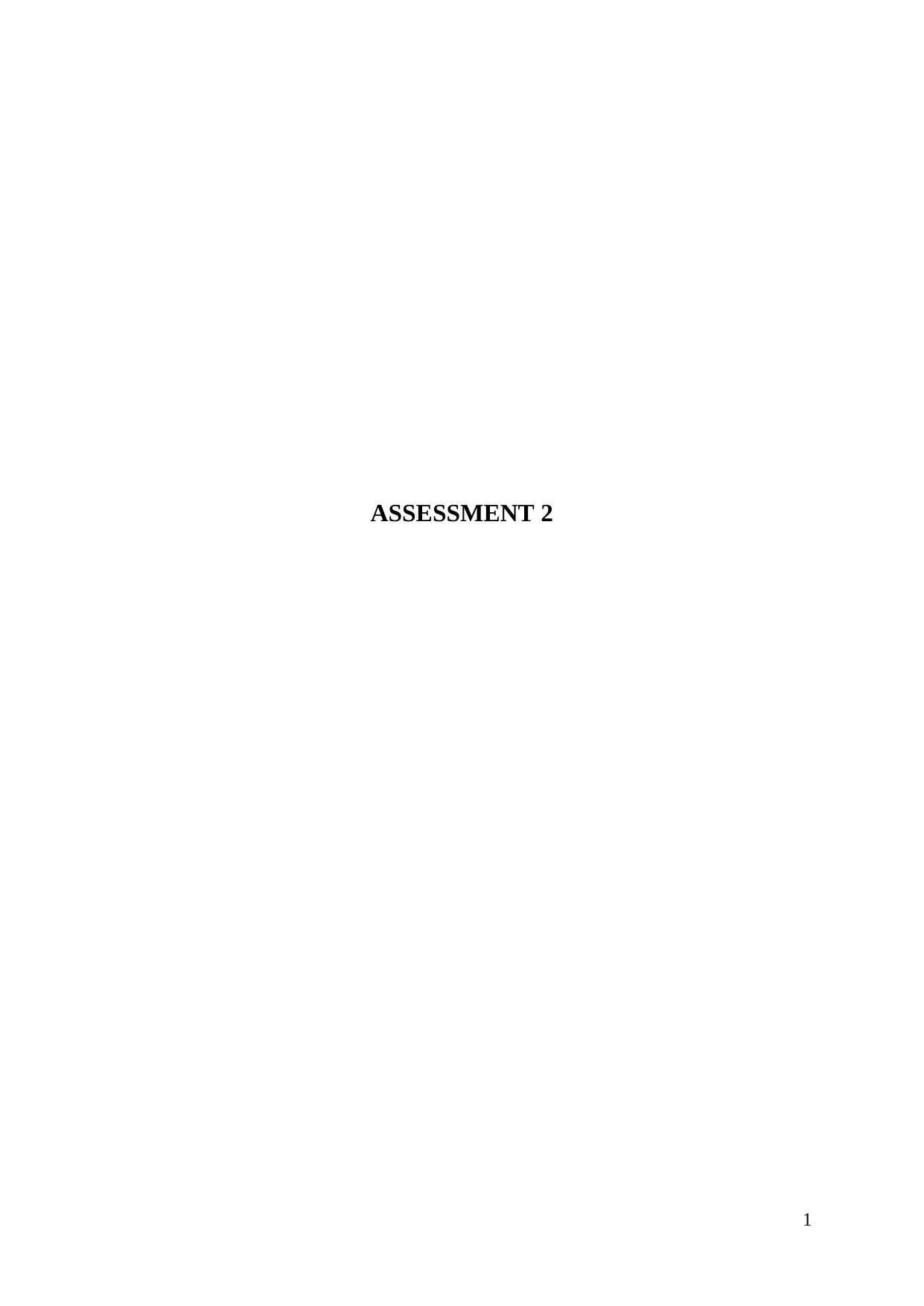
ASSESSMENT 2
1
1
Paraphrase This Document
Need a fresh take? Get an instant paraphrase of this document with our AI Paraphraser
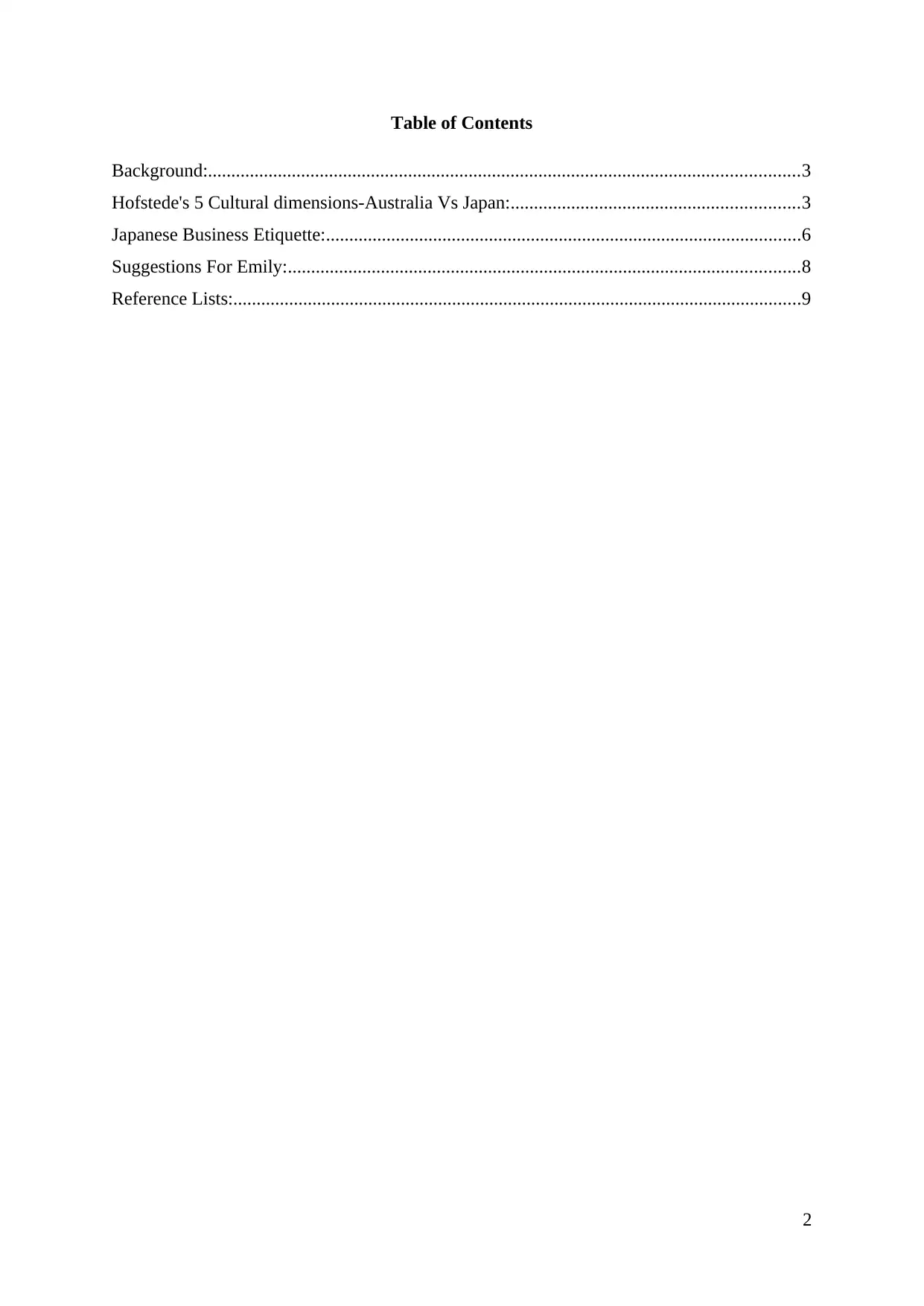
Table of Contents
Background:...............................................................................................................................3
Hofstede's 5 Cultural dimensions-Australia Vs Japan:..............................................................3
Japanese Business Etiquette:......................................................................................................6
Suggestions For Emily:..............................................................................................................8
Reference Lists:..........................................................................................................................9
2
Background:...............................................................................................................................3
Hofstede's 5 Cultural dimensions-Australia Vs Japan:..............................................................3
Japanese Business Etiquette:......................................................................................................6
Suggestions For Emily:..............................................................................................................8
Reference Lists:..........................................................................................................................9
2

Background:
The influence of culture in the business of a particular country is prevalent. Business
organizations or house need to follow the cultural norms of the contemporary community
they are serving. Organizations or individuals, trying to expand their business in a different
culture must understand the concept of cross culture management to give their management
strategies a generalized as well as subjective dimension as per requirement of the concerned
culture, they are willing to work (Thomas and Peterson, 2017, p.11). According to the case of
the assessment project, Emily is an Australian entrepreneur working in the field of food. She
owns a shop namely, 'The Aromatic Condiment Shop' and small factory in Perth. Her
condiments are made of purely organic ingredients and are also free from harmful
preservatives. Emily wishes to expand her business to Japan, as she thinks that her products
will do good business in Japan. She is planning to planning to introduce items like, chilli
sauces, pastes, chutneys and jams to serve the needs of the Japanese community. Food is an
important component of respective culture in the society, which evinces the nature of the
culture and choices of the community people (Tjosvold, 2017, p.24). Emily understands that
she should a person directly connected with business environment of Japan. Mr. Hamasaki is
a fifty year old single man who works as a manager of a popular store in Japan. Emily is
about to come to meet Mr. Hamasaki in person in order to gather information about Japanese
business etiquette and Japanese market. This essay will concentrate on the relevant areas
Emily needs to focus before conducting meeting with Mr. Hamasaki.
Hofstede's 5 Cultural dimensions-Australia Vs Japan:
According to Hofstede, cultural patterns of different nations can be accessed on the basis of
five dimensions. Emily needs to study Hofstede's 5 Cultural dimensions for Japan in order to
prepare herself for the meeting with Mr. Hamasaki of Japan.
Power Distance:
Power distance explains the way in which social inequalities are addressed in a society. Japan
can be termed as a society with borderline hierarchy. It scored 54 in the power dimension of
the country (Degens et al. 2017, p.37). Foreign business organizations found it most
hierarchical as they had experienced slow decision making process in the business
environment of Japan. Paradoxically, the slow decision making process of Japan indicates
3
The influence of culture in the business of a particular country is prevalent. Business
organizations or house need to follow the cultural norms of the contemporary community
they are serving. Organizations or individuals, trying to expand their business in a different
culture must understand the concept of cross culture management to give their management
strategies a generalized as well as subjective dimension as per requirement of the concerned
culture, they are willing to work (Thomas and Peterson, 2017, p.11). According to the case of
the assessment project, Emily is an Australian entrepreneur working in the field of food. She
owns a shop namely, 'The Aromatic Condiment Shop' and small factory in Perth. Her
condiments are made of purely organic ingredients and are also free from harmful
preservatives. Emily wishes to expand her business to Japan, as she thinks that her products
will do good business in Japan. She is planning to planning to introduce items like, chilli
sauces, pastes, chutneys and jams to serve the needs of the Japanese community. Food is an
important component of respective culture in the society, which evinces the nature of the
culture and choices of the community people (Tjosvold, 2017, p.24). Emily understands that
she should a person directly connected with business environment of Japan. Mr. Hamasaki is
a fifty year old single man who works as a manager of a popular store in Japan. Emily is
about to come to meet Mr. Hamasaki in person in order to gather information about Japanese
business etiquette and Japanese market. This essay will concentrate on the relevant areas
Emily needs to focus before conducting meeting with Mr. Hamasaki.
Hofstede's 5 Cultural dimensions-Australia Vs Japan:
According to Hofstede, cultural patterns of different nations can be accessed on the basis of
five dimensions. Emily needs to study Hofstede's 5 Cultural dimensions for Japan in order to
prepare herself for the meeting with Mr. Hamasaki of Japan.
Power Distance:
Power distance explains the way in which social inequalities are addressed in a society. Japan
can be termed as a society with borderline hierarchy. It scored 54 in the power dimension of
the country (Degens et al. 2017, p.37). Foreign business organizations found it most
hierarchical as they had experienced slow decision making process in the business
environment of Japan. Paradoxically, the slow decision making process of Japan indicates
3
⊘ This is a preview!⊘
Do you want full access?
Subscribe today to unlock all pages.

Trusted by 1+ million students worldwide
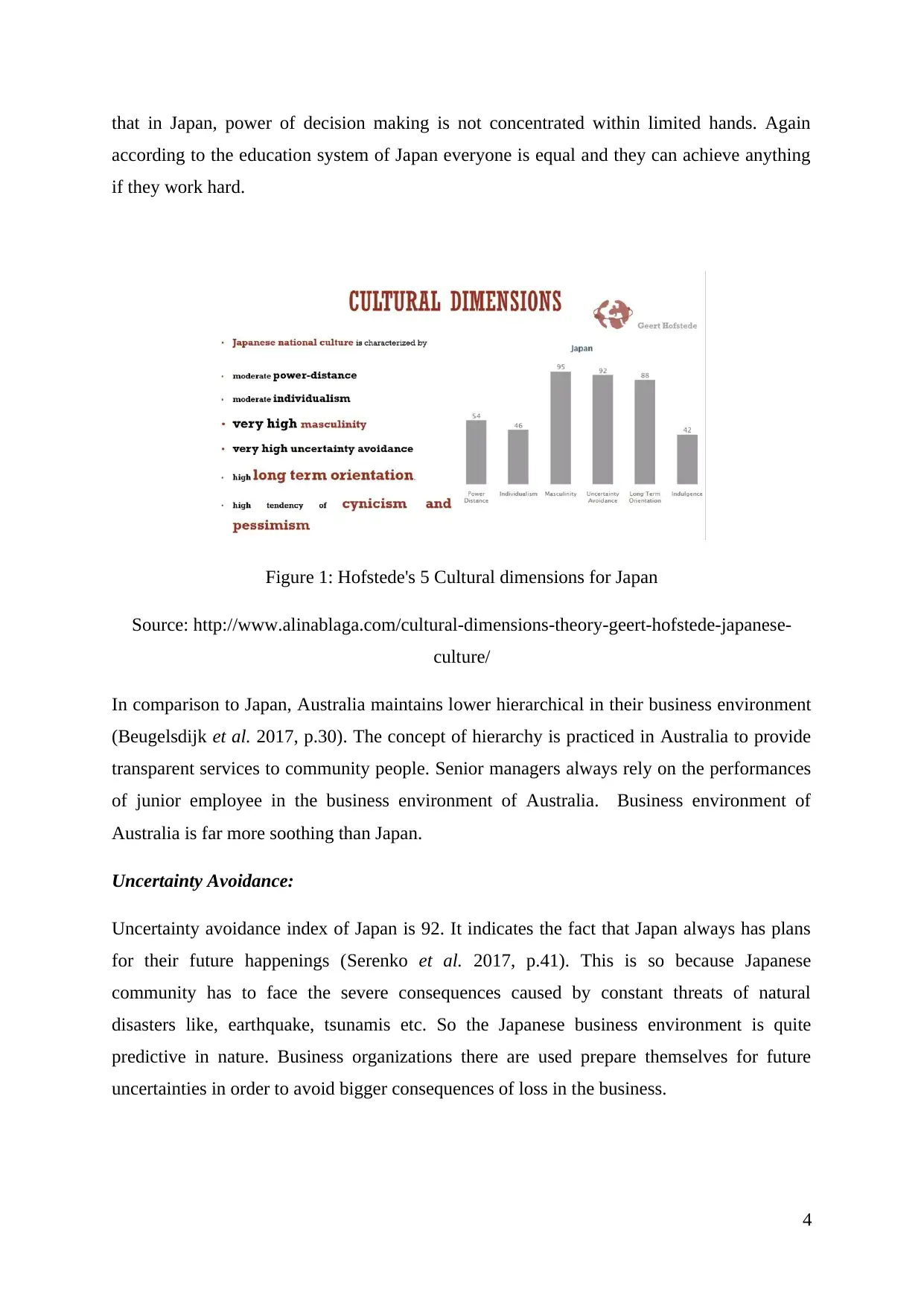
that in Japan, power of decision making is not concentrated within limited hands. Again
according to the education system of Japan everyone is equal and they can achieve anything
if they work hard.
Figure 1: Hofstede's 5 Cultural dimensions for Japan
Source: http://www.alinablaga.com/cultural-dimensions-theory-geert-hofstede-japanese-
culture/
In comparison to Japan, Australia maintains lower hierarchical in their business environment
(Beugelsdijk et al. 2017, p.30). The concept of hierarchy is practiced in Australia to provide
transparent services to community people. Senior managers always rely on the performances
of junior employee in the business environment of Australia. Business environment of
Australia is far more soothing than Japan.
Uncertainty Avoidance:
Uncertainty avoidance index of Japan is 92. It indicates the fact that Japan always has plans
for their future happenings (Serenko et al. 2017, p.41). This is so because Japanese
community has to face the severe consequences caused by constant threats of natural
disasters like, earthquake, tsunamis etc. So the Japanese business environment is quite
predictive in nature. Business organizations there are used prepare themselves for future
uncertainties in order to avoid bigger consequences of loss in the business.
4
according to the education system of Japan everyone is equal and they can achieve anything
if they work hard.
Figure 1: Hofstede's 5 Cultural dimensions for Japan
Source: http://www.alinablaga.com/cultural-dimensions-theory-geert-hofstede-japanese-
culture/
In comparison to Japan, Australia maintains lower hierarchical in their business environment
(Beugelsdijk et al. 2017, p.30). The concept of hierarchy is practiced in Australia to provide
transparent services to community people. Senior managers always rely on the performances
of junior employee in the business environment of Australia. Business environment of
Australia is far more soothing than Japan.
Uncertainty Avoidance:
Uncertainty avoidance index of Japan is 92. It indicates the fact that Japan always has plans
for their future happenings (Serenko et al. 2017, p.41). This is so because Japanese
community has to face the severe consequences caused by constant threats of natural
disasters like, earthquake, tsunamis etc. So the Japanese business environment is quite
predictive in nature. Business organizations there are used prepare themselves for future
uncertainties in order to avoid bigger consequences of loss in the business.
4
Paraphrase This Document
Need a fresh take? Get an instant paraphrase of this document with our AI Paraphraser
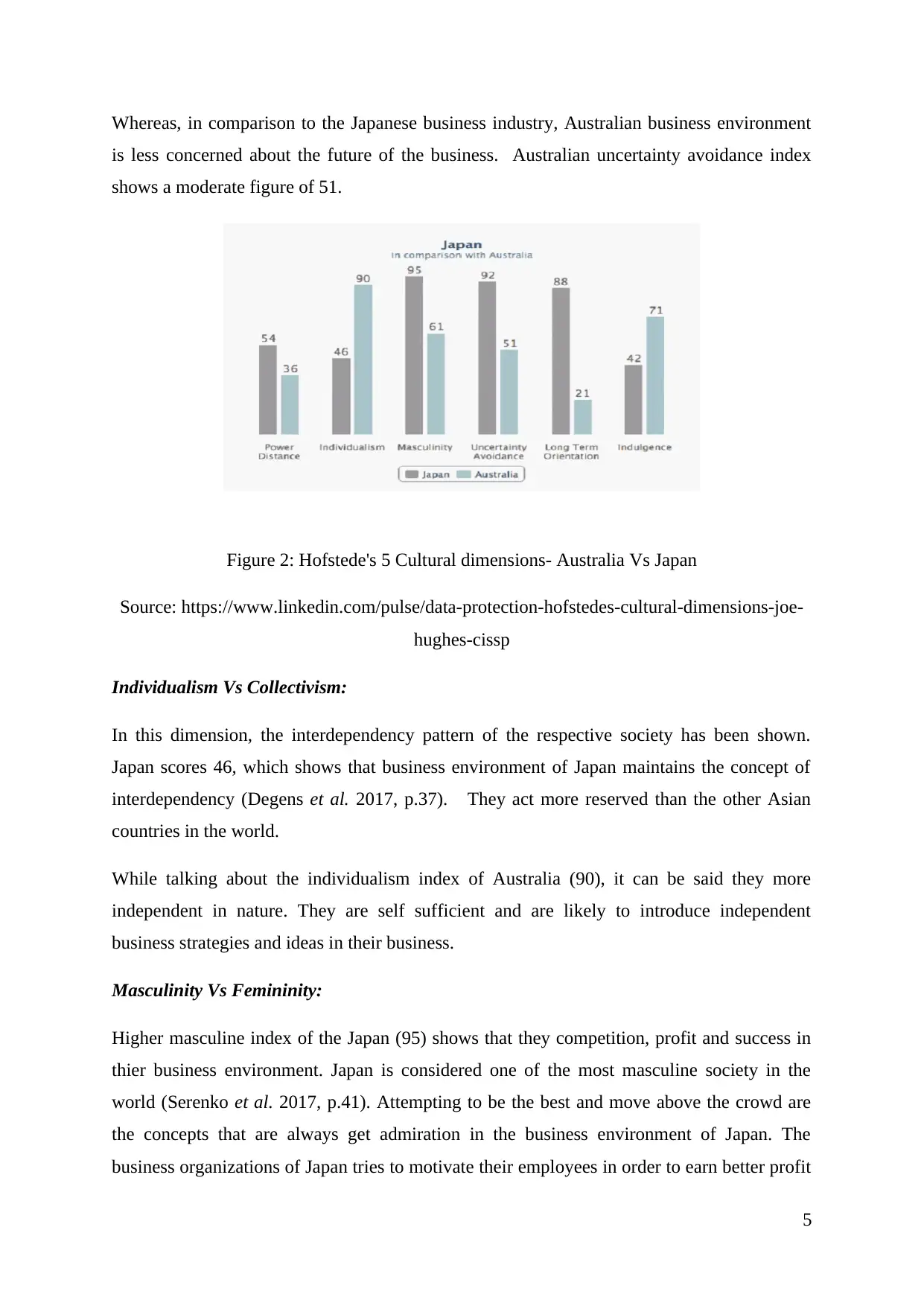
Whereas, in comparison to the Japanese business industry, Australian business environment
is less concerned about the future of the business. Australian uncertainty avoidance index
shows a moderate figure of 51.
Figure 2: Hofstede's 5 Cultural dimensions- Australia Vs Japan
Source: https://www.linkedin.com/pulse/data-protection-hofstedes-cultural-dimensions-joe-
hughes-cissp
Individualism Vs Collectivism:
In this dimension, the interdependency pattern of the respective society has been shown.
Japan scores 46, which shows that business environment of Japan maintains the concept of
interdependency (Degens et al. 2017, p.37). They act more reserved than the other Asian
countries in the world.
While talking about the individualism index of Australia (90), it can be said they more
independent in nature. They are self sufficient and are likely to introduce independent
business strategies and ideas in their business.
Masculinity Vs Femininity:
Higher masculine index of the Japan (95) shows that they competition, profit and success in
thier business environment. Japan is considered one of the most masculine society in the
world (Serenko et al. 2017, p.41). Attempting to be the best and move above the crowd are
the concepts that are always get admiration in the business environment of Japan. The
business organizations of Japan tries to motivate their employees in order to earn better profit
5
is less concerned about the future of the business. Australian uncertainty avoidance index
shows a moderate figure of 51.
Figure 2: Hofstede's 5 Cultural dimensions- Australia Vs Japan
Source: https://www.linkedin.com/pulse/data-protection-hofstedes-cultural-dimensions-joe-
hughes-cissp
Individualism Vs Collectivism:
In this dimension, the interdependency pattern of the respective society has been shown.
Japan scores 46, which shows that business environment of Japan maintains the concept of
interdependency (Degens et al. 2017, p.37). They act more reserved than the other Asian
countries in the world.
While talking about the individualism index of Australia (90), it can be said they more
independent in nature. They are self sufficient and are likely to introduce independent
business strategies and ideas in their business.
Masculinity Vs Femininity:
Higher masculine index of the Japan (95) shows that they competition, profit and success in
thier business environment. Japan is considered one of the most masculine society in the
world (Serenko et al. 2017, p.41). Attempting to be the best and move above the crowd are
the concepts that are always get admiration in the business environment of Japan. The
business organizations of Japan tries to motivate their employees in order to earn better profit
5
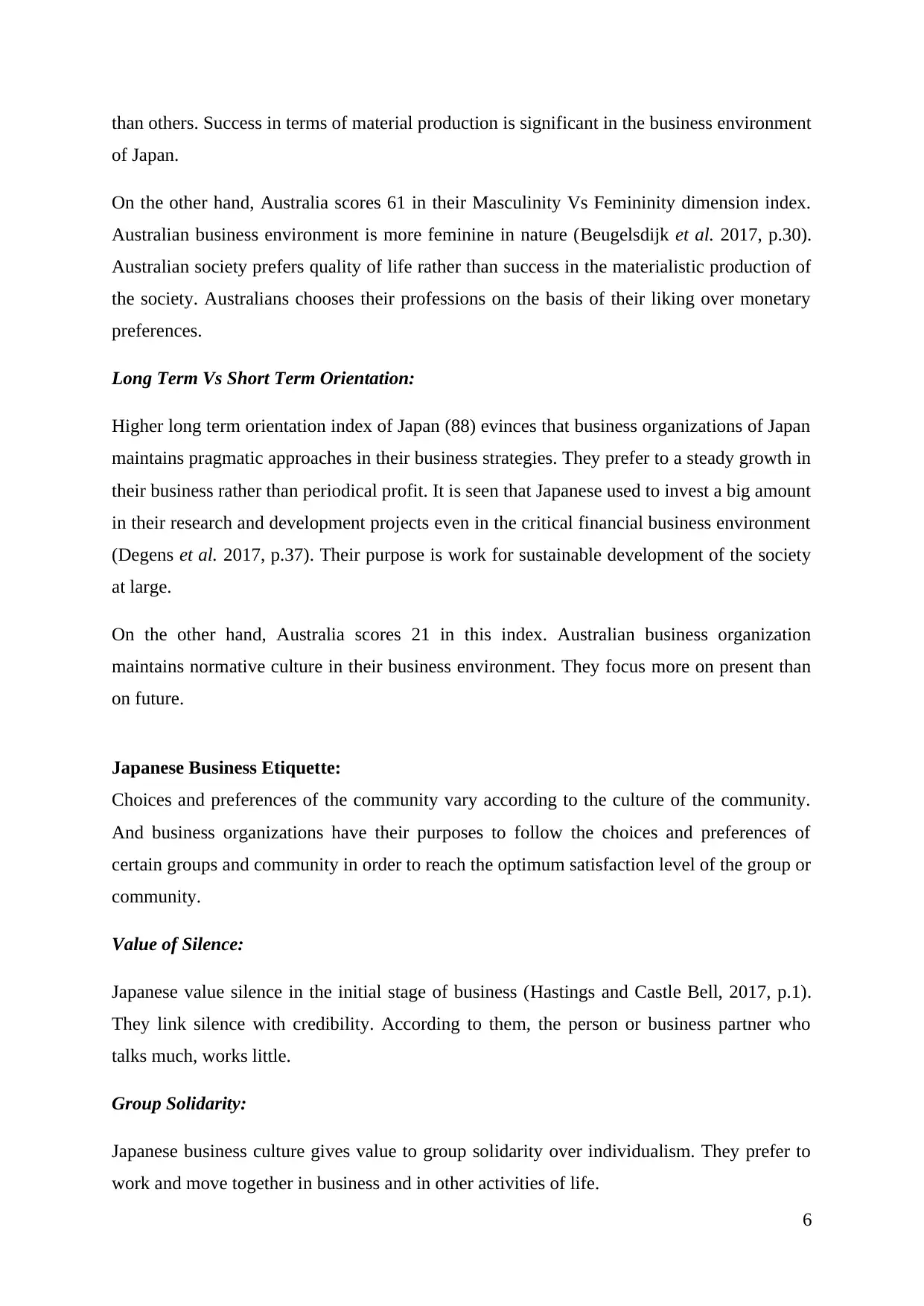
than others. Success in terms of material production is significant in the business environment
of Japan.
On the other hand, Australia scores 61 in their Masculinity Vs Femininity dimension index.
Australian business environment is more feminine in nature (Beugelsdijk et al. 2017, p.30).
Australian society prefers quality of life rather than success in the materialistic production of
the society. Australians chooses their professions on the basis of their liking over monetary
preferences.
Long Term Vs Short Term Orientation:
Higher long term orientation index of Japan (88) evinces that business organizations of Japan
maintains pragmatic approaches in their business strategies. They prefer to a steady growth in
their business rather than periodical profit. It is seen that Japanese used to invest a big amount
in their research and development projects even in the critical financial business environment
(Degens et al. 2017, p.37). Their purpose is work for sustainable development of the society
at large.
On the other hand, Australia scores 21 in this index. Australian business organization
maintains normative culture in their business environment. They focus more on present than
on future.
Japanese Business Etiquette:
Choices and preferences of the community vary according to the culture of the community.
And business organizations have their purposes to follow the choices and preferences of
certain groups and community in order to reach the optimum satisfaction level of the group or
community.
Value of Silence:
Japanese value silence in the initial stage of business (Hastings and Castle Bell, 2017, p.1).
They link silence with credibility. According to them, the person or business partner who
talks much, works little.
Group Solidarity:
Japanese business culture gives value to group solidarity over individualism. They prefer to
work and move together in business and in other activities of life.
6
of Japan.
On the other hand, Australia scores 61 in their Masculinity Vs Femininity dimension index.
Australian business environment is more feminine in nature (Beugelsdijk et al. 2017, p.30).
Australian society prefers quality of life rather than success in the materialistic production of
the society. Australians chooses their professions on the basis of their liking over monetary
preferences.
Long Term Vs Short Term Orientation:
Higher long term orientation index of Japan (88) evinces that business organizations of Japan
maintains pragmatic approaches in their business strategies. They prefer to a steady growth in
their business rather than periodical profit. It is seen that Japanese used to invest a big amount
in their research and development projects even in the critical financial business environment
(Degens et al. 2017, p.37). Their purpose is work for sustainable development of the society
at large.
On the other hand, Australia scores 21 in this index. Australian business organization
maintains normative culture in their business environment. They focus more on present than
on future.
Japanese Business Etiquette:
Choices and preferences of the community vary according to the culture of the community.
And business organizations have their purposes to follow the choices and preferences of
certain groups and community in order to reach the optimum satisfaction level of the group or
community.
Value of Silence:
Japanese value silence in the initial stage of business (Hastings and Castle Bell, 2017, p.1).
They link silence with credibility. According to them, the person or business partner who
talks much, works little.
Group Solidarity:
Japanese business culture gives value to group solidarity over individualism. They prefer to
work and move together in business and in other activities of life.
6
⊘ This is a preview!⊘
Do you want full access?
Subscribe today to unlock all pages.

Trusted by 1+ million students worldwide
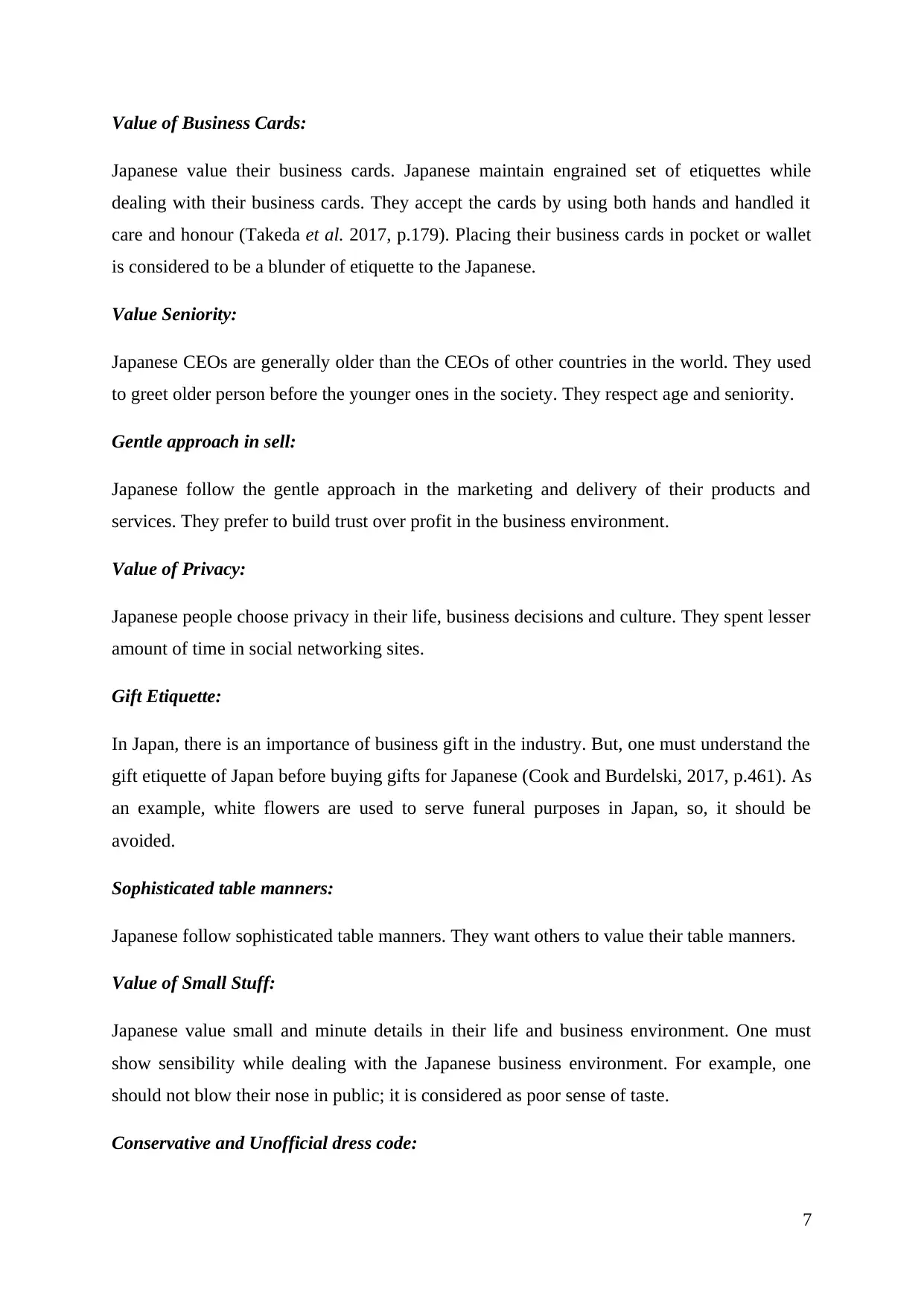
Value of Business Cards:
Japanese value their business cards. Japanese maintain engrained set of etiquettes while
dealing with their business cards. They accept the cards by using both hands and handled it
care and honour (Takeda et al. 2017, p.179). Placing their business cards in pocket or wallet
is considered to be a blunder of etiquette to the Japanese.
Value Seniority:
Japanese CEOs are generally older than the CEOs of other countries in the world. They used
to greet older person before the younger ones in the society. They respect age and seniority.
Gentle approach in sell:
Japanese follow the gentle approach in the marketing and delivery of their products and
services. They prefer to build trust over profit in the business environment.
Value of Privacy:
Japanese people choose privacy in their life, business decisions and culture. They spent lesser
amount of time in social networking sites.
Gift Etiquette:
In Japan, there is an importance of business gift in the industry. But, one must understand the
gift etiquette of Japan before buying gifts for Japanese (Cook and Burdelski, 2017, p.461). As
an example, white flowers are used to serve funeral purposes in Japan, so, it should be
avoided.
Sophisticated table manners:
Japanese follow sophisticated table manners. They want others to value their table manners.
Value of Small Stuff:
Japanese value small and minute details in their life and business environment. One must
show sensibility while dealing with the Japanese business environment. For example, one
should not blow their nose in public; it is considered as poor sense of taste.
Conservative and Unofficial dress code:
7
Japanese value their business cards. Japanese maintain engrained set of etiquettes while
dealing with their business cards. They accept the cards by using both hands and handled it
care and honour (Takeda et al. 2017, p.179). Placing their business cards in pocket or wallet
is considered to be a blunder of etiquette to the Japanese.
Value Seniority:
Japanese CEOs are generally older than the CEOs of other countries in the world. They used
to greet older person before the younger ones in the society. They respect age and seniority.
Gentle approach in sell:
Japanese follow the gentle approach in the marketing and delivery of their products and
services. They prefer to build trust over profit in the business environment.
Value of Privacy:
Japanese people choose privacy in their life, business decisions and culture. They spent lesser
amount of time in social networking sites.
Gift Etiquette:
In Japan, there is an importance of business gift in the industry. But, one must understand the
gift etiquette of Japan before buying gifts for Japanese (Cook and Burdelski, 2017, p.461). As
an example, white flowers are used to serve funeral purposes in Japan, so, it should be
avoided.
Sophisticated table manners:
Japanese follow sophisticated table manners. They want others to value their table manners.
Value of Small Stuff:
Japanese value small and minute details in their life and business environment. One must
show sensibility while dealing with the Japanese business environment. For example, one
should not blow their nose in public; it is considered as poor sense of taste.
Conservative and Unofficial dress code:
7
Paraphrase This Document
Need a fresh take? Get an instant paraphrase of this document with our AI Paraphraser
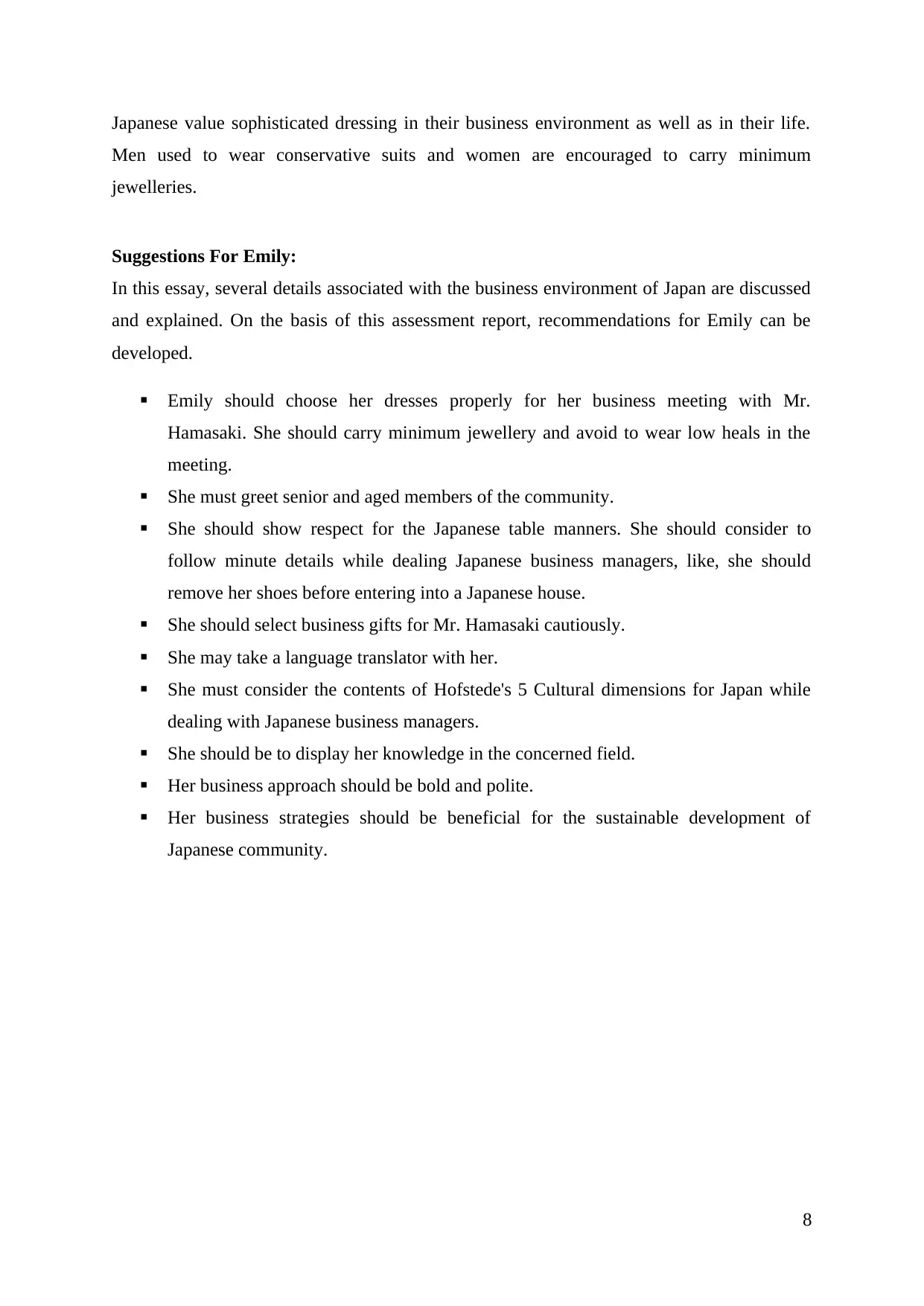
Japanese value sophisticated dressing in their business environment as well as in their life.
Men used to wear conservative suits and women are encouraged to carry minimum
jewelleries.
Suggestions For Emily:
In this essay, several details associated with the business environment of Japan are discussed
and explained. On the basis of this assessment report, recommendations for Emily can be
developed.
Emily should choose her dresses properly for her business meeting with Mr.
Hamasaki. She should carry minimum jewellery and avoid to wear low heals in the
meeting.
She must greet senior and aged members of the community.
She should show respect for the Japanese table manners. She should consider to
follow minute details while dealing Japanese business managers, like, she should
remove her shoes before entering into a Japanese house.
She should select business gifts for Mr. Hamasaki cautiously.
She may take a language translator with her.
She must consider the contents of Hofstede's 5 Cultural dimensions for Japan while
dealing with Japanese business managers.
She should be to display her knowledge in the concerned field.
Her business approach should be bold and polite.
Her business strategies should be beneficial for the sustainable development of
Japanese community.
8
Men used to wear conservative suits and women are encouraged to carry minimum
jewelleries.
Suggestions For Emily:
In this essay, several details associated with the business environment of Japan are discussed
and explained. On the basis of this assessment report, recommendations for Emily can be
developed.
Emily should choose her dresses properly for her business meeting with Mr.
Hamasaki. She should carry minimum jewellery and avoid to wear low heals in the
meeting.
She must greet senior and aged members of the community.
She should show respect for the Japanese table manners. She should consider to
follow minute details while dealing Japanese business managers, like, she should
remove her shoes before entering into a Japanese house.
She should select business gifts for Mr. Hamasaki cautiously.
She may take a language translator with her.
She must consider the contents of Hofstede's 5 Cultural dimensions for Japan while
dealing with Japanese business managers.
She should be to display her knowledge in the concerned field.
Her business approach should be bold and polite.
Her business strategies should be beneficial for the sustainable development of
Japanese community.
8

Reference Lists:
Beugelsdijk, S., Kostova, T. and Roth, K., 2017. An overview of Hofstede-inspired country-
level culture research in international business since 2006. Journal of International Business
Studies, 48(1), pp.30-47.
Cook, H.M. and Burdelski, M., 2017. (Im) politeness: Language Socialization. In The
Palgrave Handbook of Linguistic (Im) politeness (pp. 461-488). Palgrave Macmillan UK.
Degens, N., Endrass, B., Hofstede, G.J., Beulens, A. and André, E., 2017. ‘What I see is not
what you get’: why culture-specific behaviours for virtual characters should be user-tested
across cultures. AI & society, 32(1), pp.37-49.
Gelfand, M.J., Aycan, Z., Erez, M. and Leung, K., 2017. Cross-cultural industrial
organizational psychology and organizational behavior: A hundred-year journey. Journal of
Applied Psychology, 102(3), p.514.
Hastings, S.O. and Castle Bell, G., 2017. Facing our Heuristic Limits: Expanding the
Terminology for Types of Positive Face. Communication Quarterly, pp.1-15.
http://www.alinablaga.com/cultural-dimensions-theory-geert-hofstede-japanese-culture/
https://www.linkedin.com/pulse/data-protection-hofstedes-cultural-dimensions-joe-hughes-
cissp
Serenko, A., Sato, O., Palvia, P.C., Turan, A.H. and Sasaki, H., 2017. The Effect of Work-
Home Conflict on IT Employees in Japan: The Moderating Role of Conscientiousness.
Takeda, T., Kida, N. and Hara, T., 2017, July. Appropriateness and Impression Evaluation of
Japanese Seated Bow. In International Conference on Digital Human Modeling and
Applications in Health, Safety, Ergonomics and Risk Management (pp. 179-187). Springer,
Cham.
Thomas, D.C. and Peterson, M.F., 2017. Cross-cultural management: Essential concepts.
Sage Publications.
Tjosvold, D., 2017. Cross-cultural management: foundations and future. Routledge.
9
Beugelsdijk, S., Kostova, T. and Roth, K., 2017. An overview of Hofstede-inspired country-
level culture research in international business since 2006. Journal of International Business
Studies, 48(1), pp.30-47.
Cook, H.M. and Burdelski, M., 2017. (Im) politeness: Language Socialization. In The
Palgrave Handbook of Linguistic (Im) politeness (pp. 461-488). Palgrave Macmillan UK.
Degens, N., Endrass, B., Hofstede, G.J., Beulens, A. and André, E., 2017. ‘What I see is not
what you get’: why culture-specific behaviours for virtual characters should be user-tested
across cultures. AI & society, 32(1), pp.37-49.
Gelfand, M.J., Aycan, Z., Erez, M. and Leung, K., 2017. Cross-cultural industrial
organizational psychology and organizational behavior: A hundred-year journey. Journal of
Applied Psychology, 102(3), p.514.
Hastings, S.O. and Castle Bell, G., 2017. Facing our Heuristic Limits: Expanding the
Terminology for Types of Positive Face. Communication Quarterly, pp.1-15.
http://www.alinablaga.com/cultural-dimensions-theory-geert-hofstede-japanese-culture/
https://www.linkedin.com/pulse/data-protection-hofstedes-cultural-dimensions-joe-hughes-
cissp
Serenko, A., Sato, O., Palvia, P.C., Turan, A.H. and Sasaki, H., 2017. The Effect of Work-
Home Conflict on IT Employees in Japan: The Moderating Role of Conscientiousness.
Takeda, T., Kida, N. and Hara, T., 2017, July. Appropriateness and Impression Evaluation of
Japanese Seated Bow. In International Conference on Digital Human Modeling and
Applications in Health, Safety, Ergonomics and Risk Management (pp. 179-187). Springer,
Cham.
Thomas, D.C. and Peterson, M.F., 2017. Cross-cultural management: Essential concepts.
Sage Publications.
Tjosvold, D., 2017. Cross-cultural management: foundations and future. Routledge.
9
⊘ This is a preview!⊘
Do you want full access?
Subscribe today to unlock all pages.

Trusted by 1+ million students worldwide
1 out of 9
Related Documents
Your All-in-One AI-Powered Toolkit for Academic Success.
+13062052269
info@desklib.com
Available 24*7 on WhatsApp / Email
![[object Object]](/_next/static/media/star-bottom.7253800d.svg)
Unlock your academic potential
Copyright © 2020–2026 A2Z Services. All Rights Reserved. Developed and managed by ZUCOL.





